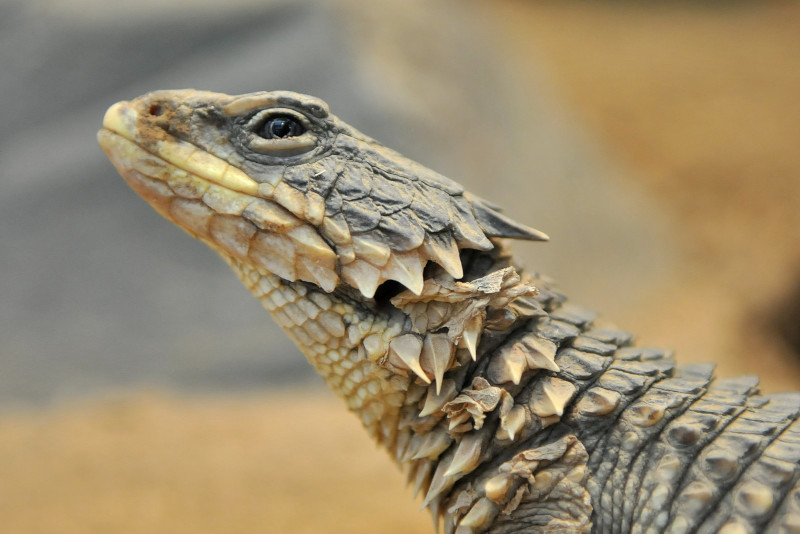Giant Girdled Lizard Facts
- One of the most frequently used common names for this marvel of Nature and evolution is the deceptive term of Giant Girdled Lizard. It also goes by several other names, though. These include the sungazer, giant zonure, and the giant dragon lizard.
- Its scientific name, however, remains that of Smaug giganteus. Formerly, however, it bore another technical name, until placed in another genus. That was the term Cordylus giganteus. Regardless of which of these names one uses for it, it’s an amazing species.
- It owes its scientific recognition to the well known Scottish explorer and zoologist Sir Andrew Smith. He made the first recorder formal acknowledgment of it as a separate and distinct species. This notable event occurred in the year 1844.
- The current situation for the magnificent Giant Girdled Lizard remains moderately precarious. The IUCN, therefore, presently lists it as Vulnerable. This status appears of the organization’s routinely updated Red List of Threatened Species.
- Just as countless other species around the world, it faces numerous threats to its continued existence. Habitat loss certainly forms one of these. Its greatest threat, however, no doubt comes in the form of the ongoing effects of climate change.
Related Articles
Giant Girdled Lizard Physical Description
The remarkable Giant Girdled Lizard bears a fairly ironic common name, in this instance. That’s because it’s not at all a large variety of lizard, especially compared to some others. It nonetheless manages to impress those who encounter it for reasons other than simple size.
That simple physical size, nonetheless bears mentioning, of course. This species does display the physiological characteristic of sexual dimorphism, but not in size. In this respect, this incredible creature closely mirrors many of its numerous related species.
Overall, though, physically mature individuals attain an average snout-to-tail length of 7.9 – 13.8 in (20 – 35 cm). Exceptional specimens, though, do occasionally occur. These physically impressive individuals sometimes grow to lengths measuring as much as 15.8 in (40 cm).
The color patterns also vary according to age, though not by gender. Young individuals typically present more intense markings. These usually include reddish-brown bars on the back. Yellow and black bands also appear, with many reddish-orange scales on the tail.
The adult Giant Girdled Lizard, however, displays a more subdued color pattern on its scales. That often includes shades of tan and yellow. It’s the scales, though, that distinguish the genders. That’s because the male has larger scales on its forearms than the female.
- Kingdom: Animalia
- Phylum: Chordata
- Class: Reptilia
- Order: Squamata
- Family: Cordylidae
- Genus: Smaug
- Species: S. giganteus
Giant Girdled Lizard Distribution, Habitat, and Ecology
Unfortunately, the awesome Giant Girdled Lizard appear to only inhabit a small portion of the world. That’s due to the fact that its known natural range consists solely of a certain part of the continent of Africa. Even there, though, its presence remains limited.
More precisely, it seems to live solely in what now forms the country of South Africa. Its restrictions don’t simply stop there, however. In point of fact, this wonder of evolution currently lives in only 3 small provinces. All appear in the southern part of the country.
This marvelous creature further seems to possess extremely specific habitat preferences and requirements. That’s due to the fact that all known populations live in one type of ecosystem only. More specifically, the lizard only lives in regions of open grasslands.
Unlike most related species, this reptile evolved a more secluded preference for its shelter. Most of its kin live on rocks. It, however, chooses to make its home in shallow burrows on the open grassland. These sheltering burrows each individual usually creates for itself.
The stunning Giant Girdled Lizard also typically lives in small colonies. Like most lizards, it also evolved as a carnivore. Adults feed on various insects, most especially beetles. The young, meanwhile, mainly eat ants, and other small, locally numerous insects.
It’s also a diurnal species, and loves to sun itself in the sun. This it typically does near the entrance of its burrow, though, for safety. One of its other common names is the Sungazer. This derives from its tendency to sit near the entrance of the burrow, and peer at the sun.
Species Sharing Its Range
Check out our other articles on 4 Herbaceous Plants of Virginia, Finless Porpoise, Lake Posta Fibreno, Guinan cock-of-the-rock, Arrowleaf Elephant Ear, Red-Tailed Bumblebee

